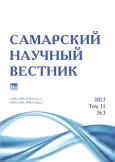Оценка экологического состояния особо охраняемой природной территории «Озеро Дус-Холь» в связи с рекреационным использованием
- Авторы: Монгуш Ч.Б.1, Андреева И.В.2, Самбыла Ч.Н.1
-
Учреждения:
- Тувинский научный центр
- Институт водных и экологических проблем СО РАН
- Выпуск: Том 11, № 3 (2022)
- Страницы: 91-95
- Раздел: Биологические науки
- URL: https://journals.rcsi.science/2309-4370/article/view/114884
- DOI: https://doi.org/10.55355/snv2022113110
- ID: 114884
Цитировать
Полный текст
Аннотация
В статье освещены итоги полевых комплексных геоэкологических исследований на озере Дус-Холь летом 2021 г. Под руководством Тувинского научного центра в рамках проекта по определению предельно допустимых и оптимальных рекреационных нагрузок на особо охраняемую природную территорию собраны и актуализированы данные о посетителях и состоянии экосистемы побережья. Озеро Дус-Холь (Сватиково) расположено в Тандинском кожууне Республики Тыва, в 3 км от оз. Хадын. Дус-Холь является одним из массово посещаемых озер на территории Республики Тыва, оно привлекает наличием лечебных грязей, высококачественной рапой, гелиотермами и питьевыми минеральными водами. На территории озера введен режим особо охраняемой территории регионального значения, основной целью которого является сохранение природных водно-болотных комплексов в естественном состоянии и защита от негативного воздействия антропогенных и техногенных факторов. На основе полученных данных определены виды отдыха, значения рекреационной нагрузки и степень рекреационной дигрессии экосистемы. Предложены пути оптимизации рекреационного природопользования на озере. Учет посетителей выполнен методом маршрутного подсчета в пик сезона. Сбор данных о видах и масштабах рекреационной деятельности, а также степени рекреационной дигрессии природных комплексов побережья производился путем визуальной оценки и опросов.
Полный текст
Открыть статью на сайте журналаОб авторах
Чинчи Буяновна Монгуш
Тувинский научный центр
Email: chinchi96@mail.ru
главный специалист отдела научного сопровождения регионального развития
Россия, г. КызылИрина Владимировна Андреева
Институт водных и экологических проблем СО РАН
Email: direction-altai@yandex.ru
кандидат географических наук, старший научный сотрудник лаборатории водных ресурсов и водопользования
Россия, г. БарнаулЧойган Николаевна Самбыла
Тувинский научный центр
Автор, ответственный за переписку.
Email: choigansam@mail.ru
доктор биологических наук, доцент, директор
Россия, г. КызылСписок литературы
- Шыырап А.А., Биче-оол Т.Н. ГИС-анализ площади озера Дус-Холь (Сватиково) Республики Тыва // Актуальные проблемы исследования этноэкологических и этнокультурных традиций народов Саяно-Алтая: мат-лы III междунар. науч.-практ. конф. молодых ученых, аспирантов и студентов. Кызыл: Изд-во ТувГУ, 2015. С. 256–257.
- Курортологическая оценка местности в пределах озера Дус-Холь (Сватиково) // Отчет по хоздоговорной НИР № 113-Р/2012 / сост. А.А. Зайцев, Н.Г. Сидорина и др. Томск, 2013.
- Аракчаа К.Д., Салчак С.М., Копылова Ю.Г., Хващевская А.А. Озеро Дус-Холь: геохимия и перспективы лечебно-оздоровительного освоения // Курортная база и природные лечебно-оздоровительные местности Тувы и сопредельных регионов: опыт и перспективы использования в целях профилактики заболеваний, лечения и реабилитации больных: мат-лы III междунар. науч.-практ. конф. Кызыл, 2017. С. 167–175.
- Кадастровое дело № 002. Памятник природы регионального значения «Озеро Дус-Холь» (Фонды Министерства лесного хозяйства и природопользования Республики Тыва, ГБУ «Дирекция по особо охраняемым природным территориям Республики Тыва»).
- Пиннекер Е.В. Минеральные воды Тувы. Кызыл: Тув. кн. изд-во, 1968. 106 с.
- Заика В.В. Озеро Дус-Холь (Сватиково) в вегетационный период. Центральная Тува // Вестник Тувинского государственного университета. Естественные и сельскохозяйственные науки. 2020. № 1 (57). С. 20–30.
- Литвиненко Л.И., Литвиненко А.И., Бойко Е.Г. Артемия в озёрах Западной Сибири. Новосибирск: Наука, 2009. 304 с.
- Van Stappen G., Litvinenko L.I., Litvinenko A.I., Boiko E.G., Marden B., Sorgeloos P. A survey of Artemia resources of Southwest Siberia (Russian Federation) // Reviews in Fisheries Science. 2009. Vol. 17, iss. 1. P. 116–148. doi: 10.1080/10641260802590095.
- О памятниках природы республиканского значения на территории Республики Тыва: постановление Правительства Республики Тыва от 28.02.2007 № 294 [Электронный ресурс] // Электронный фонд правовых и нормативно-технических документов. https://docs.cntd.ru/document/802092500.
- Репшас Э.А. Особенности дигрессии и регрессии рекреационных лесов Литовской ССР // Рекреационное лесопользование в СССР: сб. ст. М.: Наука, 1983. С. 44–55.
- Аниськин В.О. Геоэкологические условия рекреационного использования территории бассейна Верхней Угры: дис. … канд. геогр. наук: 25.00.36. Смоленск, 2003. 234 с.
- Андреева И.В., Самбыла Ч.Н., Пузанов А.В., Монгуш Ч.Б., Оюн А.М. Оценка и нормирование рекреационных нагрузок на побережье озера Дус-Холь (Тыва) // Известия Русского географического общества. 2022. Т. 154, № 3. С. 77–85.
- Об установлении размера платы за посещение особо охраняемых природных территорий республиканского значения памятника природы «Озеро Дус-Холь» и государственного природного заказника «Дургенский» физическими лицами, не проживающими в населенных пунктах, расположенных в границах указанных особо охраняемых природных территорий республиканского значения, и категорий физических лиц, освобождаемых от взимания такой платы: постановление Правительства Республики Тыва от 09.06.2022 № 364 [Электронный ресурс] // Официальный интернет-портал правовой информации. http://publication.pravo.gov.ru/Document/View/1700202206100002.
Дополнительные файлы







